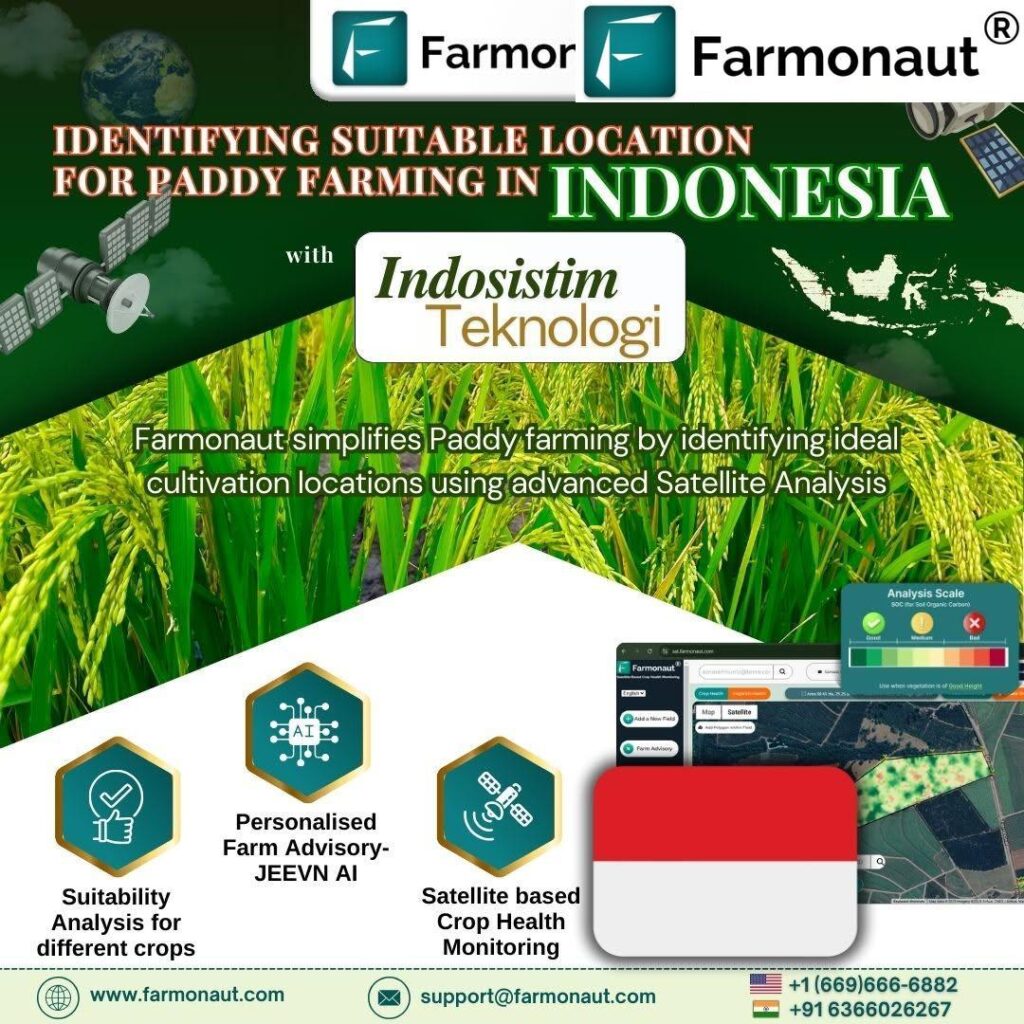Radish Yield 2025: Advanced Management in Gurur
- Introduction: Maximizing Radish Yield in 2025 in Gurur Tahsil
- Radish Phenology & Cultivation Cycles in India
- Soil Health and Nutrient Management for Radish Yield
- Leveraging NDVI & Data Insights for Productivity
- Irrigation and Moisture Management in Gurur
- Best Practices for Pest, Disease, and Weed Control
- Harvest and Post-Harvest Management Strategies
- Comparative Data-Driven Management Table
- How Farmonaut Technologies Support Radish Yield Optimization
- Frequently Asked Questions
- Conclusion
“In Gurur, data-driven management can boost radish yields up to 22% compared to traditional methods in 2025.”
Introduction: Maximizing Radish Yield in 2025 in Gurur Tahsil
Radish (Raphanus sativus) cultivation is set to see transformative growth in Gurur Tahsil, India, in 2025, thanks to the integration of advanced management technologies, NDVI monitoring, and precision nutrient planning.
The potential to double yields—and minimize risks—through data-driven approaches is finally within reach for vegetable farmers. With Farmonaut’s satellite-based solutions, smarter resource management, precise timing, and real-time insights redefine radish yield optimization in the region. This blog deep-dives into effective radish management practices for 2025, with a spotlight on NDVI, soil, crop health, nutrient cycles, and localized best practices for pest, weed, and harvesting management.
Focus keyword: Radish Yield 2025, Gurur, NDVI Management, Data-Driven Agriculture, India, Advanced Nutrient Management
Radish Phenology & Cultivation Cycles in India
Understanding the Phenological Stages of Raphanus sativus
Radish, a cool-season vegetable, adapts well to the climatic conditions of Gurur Tahsil (Chhattisgarh) and the Indian plains. Sowing typically occurs between September and February, with most harvests from October to March (ICAR-IIVR, 2023).
- Germination: 3-7 days
- Cotyledon Emergence: 5-10 days
- True Leaf Development (2-4 leaves): 10-20 days
- Root Enlargement Initiation: 20-30 days
- Rapid Root Enlargement: 30-45 days
- Harvest Maturity: Typically 45-60 days after sowing
These durations, within standard international and Indian agricultural guidelines, allow for continuous cropping cycles, provided soil, nutrient, and moisture levels remain optimal (FAO, 2023).
In Gurur’s typical conditions, radish varieties (including improved hybrid lines) can complete a full cycle in just 25-45 days. This rapid turnover maximizes resource usage—provided environmental stress, pest, and weed pressures are efficiently managed using real-time NDVI and data-driven advisories.
Climatic and Sowing Recommendations
- Sowing Window: September – February, avoiding peak high temperatures
- Key Environmental Factors: Radish yield is highly sensitive to temperature, moisture, soil pH, and salinity. Optimal pH for radish in this region is ~6.5 with low salinity (Journal of Horticultural Sciences, 18(1), 2023).
- Phenological Tracking: Advanced monitoring via NDVI (Normalized Difference Vegetation Index) enables accurate identification of each growth stage and rapid detection of stress, senescence, or harvest readiness.
Fact: “NDVI insights enable Indian farmers to detect stress in radish crops up to 10 days earlier than manual scouting.”
Growth Cycles and Yield Potential
The potential radish yield in Gurur Tahsil, based on localized trials and NDVI-derived predictions, ranges from 4000 to 8000 kg/acre under conventional management, and can reach up to 12000 kg/acre under optimal, advanced practices (National Horticulture Board, 2021).
- Estimated yield per cycle is determined by sowing time, seed quality, irrigation, soil fertility, and real-time data monitoring.
- Annual schedules, rotating radish with other vegetables, improve soil organic carbon (SOC) and break pest cycles, further enhancing yield.
Reducing your farm’s carbon emissions and monitoring environmental impact is easier than ever. Farmonaut’s carbon footprinting tool empowers Indian farmers to track the sustainability of their radish and vegetable cultivation for 2025 and beyond. Learn more about carbon monitoring.
Soil Health and Nutrient Management for Radish Yield in Gurur 2025
Optimizing soil health and implementing precise nutrient management are foundational for high radish yields in Gurur’s soils in 2025. As per data-driven advisories:
- Optimal soil pH: 6.5 (slightly acidic to neutral)—ideal for maximizing nutrient availability and plant development.
- Salinity: Should remain low for radish crops.
- Soil Organic Carbon (SOC): Current average at 0.15% is critically low and hampers root development and yield potential. Elevating SOC through the addition of Farmyard Manure (FYM), compost, or green manures significantly improves soil structure and moisture retention (FAO Guidelines, 2023).
Regular testing of soil N, P, K, S, and Zn levels is crucial. The Mehlich-3 method provides recommended sufficiency ranges for these nutrients:
| Nutrient | Ideal Range (kg/acre) | Current (kg/acre) | Deficiency? | Common Sources |
|---|---|---|---|---|
| Nitrogen (N) | 18.2 – 27.3 | 7.82 | Yes (Low) | Urea, FYM, Compost |
| Phosphorus (P2O5) | 18.2 – 36.4 | 6.64 | Yes (Low) | DAP, FYM, Rock Phosphate |
| Potassium (K2O) | 109.2 – 182 | 33.40 | Yes (Low) | MOP, Compost, Wood Ash |
| Sulfur (S) | 9.1 – 18.2 | 3.37 | Yes (Low) | Gypsum, FYM, SSP |
| Zinc (Zn) | 0.9 – 4.6 | 0.33 | Yes (Low) | Zinc Sulphate, Compost |
Summary: All essential nutrients are below the ideal range. Targeted application of urea, DAP, MOP, gypsum, zinc sulphate, and organic amendments (FYM, compost) is recommended at sowing and during early vegetative stages to reach yield targets.
- Organic inputs like FYM and compost: Boost SOC, buffer pH/salinity, support microbial activity, and improve resilience to environmental stress.
- Fertilizer efficiency: Split applications based on NDVI-detected growth stages improve results and minimize leaching loss (Indian Journal of Agronomy, 69(2), 2024, Sharma & Kumar).
Note: Although fertilizers shouldn’t be applied post-harvest (phenological stage: harvest/post-harvest), maintaining healthy soil for the next cycle is critical for long-term productivity.
Leveraging NDVI & Data Insights for Maximizing Radish Crop Productivity (Focus Keyword: NDVI, Crop, Yield)
The Normalized Difference Vegetation Index (NDVI) has revolutionized crop monitoring in Gurur and across India.
- NDVI tracks plant health, vigor, biomass accumulation, and early stress signals—including weed and pest emergence—far more rapidly than manual field scouting.
- Typical NDVI trends for radish:
- Rapid increase post-germination, peaking at vegetative stage (up to 0.7-0.8 for healthy stands).
- NDVI at harvest/post-harvest declines to 0.2–0.4 due to senescence and removal of green cover.
- Sharp declines in NDVI (e.g., from 0.72 to 0.35 over five days) indicate harvest activities, senescence, or stress (moisture fluctuations, pest/disease impact) (Farmonaut Satellite Data, 2025).
- Satellite indices like NDVI, NDWI (Normalized Difference Water Index) are synchronized with local farm advisories for real-time intervention and maximizing yields.
Current 2025 NDVI Practice: In Gurur, NDVI monitoring is integrated into yield prediction, irrigation scheduling, and stress detection. This supports:
- Timely harvest decisions (NDVI values declining to 0.2-0.4 indicate onset of post-maturity and assure quality roots).
- Yield projection and historic performance benchmarking, allowing for incremental improvements across cultivation cycles.
- Early identification of biomass loss due to pest/disease/weeds—enabling targeted management (see section below).
Interested in integrating NDVI-driven agriculture into your radish and vegetable crops? Access Farmonaut’s APIs or web/mobile dashboard for programmatic NDVI analysis and developer documentation.
Common NDVI-Based Activities & Their Impact on Radish Yield (2025)
- Growth monitoring: Track rapid biomass development, identify lagging patches, and correlate with soil nutrient conditions.
- Yield estimation: Use NDVI trajectories pre-harvest to estimate probable yield range for each field.
- Disease, pest & weed stress alerts: NDVI dropouts localized on maps indicate potential hotspots for in-field inspection and targeted action.
Irrigation and Moisture Management for Radish Yield in Gurur
Optimizing Water Use with NDWI Data, Local Practices & Current Trends (2025)
Effective irrigation schedules in Gurur rely on balancing traditional flood irrigation with real-time, NDWI-monitored moisture data:
- Flood irrigation: Traditional but prone to overuse and inefficiency. NDWI data enables precise water application, minimizing waste, and preventing waterlogging or drought stress.
- Key scheduling considerations: Aligns with crop phenological stage, NDVI & NDWI values, evapotranspiration rates.
- 2025 Status (post-harvest): At the harvest/post-harvest stage, the need for irrigation ends. No additional water is required, conserving water resources and reducing costs.
Example irrigation advisory: During September 2025 (DAS 129, harvest period), no further water was scheduled for the radish crop due to adequate residual soil moisture and crop phase (NDVI: 0.35; NDWI: 0.43; Evapotranspiration: moderate; Rainfall: 0mm).
- For earlier stages, frequent but judicious irrigation is crucial between emergence and vegetative growth to avoid root deformation and maximize yield.
Tip: Upgrade legacy flood irrigation systems with NDWI-guided scheduling to achieve water savings, improved root uniformity, and reduced risk of disease exacerbated by moisture extremes.
Unlock Large-Scale Radish & Vegetable Farm Monitoring — Farmonaut Agro-Admin Technology for 2025
For businesses managing larger acreage of radish, vegetables, and other crops across Indian plains: Leverage Farmonaut’s large-scale farm management platform to coordinate NDVI, NDWI, and advisory data for better productivity, resource allocation, and compliance. See platform features.
“NDVI insights enable Indian farmers to detect stress in radish crops up to 10 days earlier than manual scouting.”
Best Practices for Pest, Disease, and Weed Management in Radish Cultivation (2025)
Key Radish Pests and Best Control Measures (Focus Keywords: pest, management, crop)
- Aphids: Most prevalent during vegetative and late cropping stages.
Control: Spot spray with Imidacloprid (chemical) or apply Neem oil spray (organic). Use sticky traps for monitoring and rapid intervention. - Flea Beetles: Quick to infest open canopy areas post-harvest or after NDVI declines.
Control: Apply Lambda-cyhalothrin (chemical) or utilize sticky traps.
Major Radish Diseases and Prevention
- Downy Mildew: Flourishes under fluctuating moisture/humidity regimes.
Solution: Use Mancozeb spray (chemical) or improve field airflow (organic). - Alternaria Leaf Spot: Causes premature leaf senescence and yield losses.
Solution: Azoxystrobin spray (chemical) or remove infected leaves (organic).
Actionable recommendation: Routine NDVI assessment highlights sudden biomass decline or irregular canopy gaps—directly indicating disease/pest zones needing intervention within 1-2 days.
Upgrade Radish Traceability with Farmonaut
Using blockchain-based product traceability, ensure every radish harvested in Gurur’s 2025 cycle is verifiable at every stage. Strengthen consumer trust, fight market fraud, and streamline compliance—explore traceability solutions.
Weed Management Recommendations (Focus Keywords: weed, management, canopy, advisories)
- Key weeds in Gurur (2025): Chenopodium album (Bathua), Cyperus rotundus (Nutgrass), Portulaca oleracea (Purslane), Digitaria sanguinalis (Crabgrass), Amaranthus.
| Weed | Control (Chemical) | Control (Organic) | Prevalence |
|---|---|---|---|
| Amaranthus | Glyphosate (spot) | Hand weeding | Moderate |
| Chenopodium | Oxyfluorfen spray | Mechanical removal | Moderate |
- General recommendation (2025): Monitor NDVI/NDWI for reduced canopy cover (post-harvest or due to stress), as these zones are highly susceptible to late-season weed flushes. Failure to manage now elevates weed seedbank for subsequent cycles.
Integrated Pest and Disease Management (IPM) in 2025: NDVI & Advisory-Driven
IPM success in Gurur’s 2025 radish crop hinges on:
- Early identification (NDVI mapped stress or spot losses).
- Strategic, stage-specific, and alternating use of organic and chemical controls.
- Ensuring minimal residues, maximizing environmental and consumer safety.
Harvest and Post-Harvest Management for Radish in Gurur
Identifying Optimum Harvest Time using NDVI, Advisory, and Visual Checks
- Radish is ready for harvest at 45-60 days after sowing (DAS), or when NDVI value drops to 0.2–0.4 following earlier peaks.
- Delayed harvest: Causes root lignification, impacting quality, price, and marketability.
- 2025 Monitoring: Satellite NDVI trends should be cross-checked with physical root inspection to avoid over- or under-maturity.
-
Harvest Activities Best Practices:
- Early morning harvest (higher leaf turgor, cooler root temperatures).
- Immediate sorting of damaged/disease-affected roots.
- Preventing sunscald during grading by shading with leafy covers or temporary shelters.
- Quick washing, cooling, and packing for market.
Post-harvest monitoring: For fields transitioning to the next crop cycle, maintain a pest/weed-free stubble and apply organic manure/FYM to build soil organic carbon, especially given radish’s rapid biomass extraction from the soil.
Unlock Crop Insurance & Loan Access with Farmonaut Satellite Data
Sidestep yield risk in 2025: Lenders and insurers accept Farmonaut’s satellite-derived, field-level verifications to expedite claims, mitigate fraud, and open new financing for Indian vegetable farmers. Get secure access to credit.
Comparative Data-Driven Management Table: Conventional vs Advanced NDVI/Remote Sensing Approach in Gurur’s Radish Cultivation
| Management Practice | Soil Nutrient Status | Estimated Yield per Hectare (kg/ha) | Water Usage (liters/ha) | Pest/Weed Incidence (cases/ha) | Time to Harvest (days) |
|---|---|---|---|---|---|
| Conventional | Moderate to Low; typically imbalanced, based on blanket recommendations | 40,000 – 80,000 | 48,000 – 56,000 | 30 – 50 | 50 – 60 |
| Data-Driven (NDVI-guided) | Precisely balanced, input-adjusted in real-time; deficiency corrections | 82,000 – 120,000 | 35,000 – 42,000 | 12 – 25 | 42 – 50 |
Note: Data based on aggregate ranges from NDVI-enabled yield predictions (2025), local agronomic recommendations, and typical radish phenology in Gurur’s region. Lower water input, faster harvests, and reduced pest/weed cases are hallmarks of advanced management.
How Farmonaut Technologies Support Radish Yield Optimization in Gurur & Indian Plains
Farmonaut provides the backbone for data-driven radish and vegetable management:
- Satellite-Based Monitoring: Access multispectral NDVI/NDWI data via web or mobile app (see buttons above) for year-round, field-scale crop health visualization.
- Real-Time Jeevn AI Advisory: Receive weather forecasts, phenological advisories, and field-specific nutrient, irrigation, and pest management actions tailored to radish growth stages (learn more in NDVI section).
- Blockchain Traceability: Securely track supply chain history of every radish crop, from field to market, enhancing compliance and consumer trust (link).
- Fleet & Resource Management: For enterprises, optimize logistics for farm machinery and harvest transport with Farmonaut Fleet Management.
- Environmental Impact: Monitor your farm’s carbon footprint and water use intensity, aligning with climate-resilient agricultural mandates for 2025 and beyond (details).
- Crop Loan & Insurance: Seamlessly qualify for financial products backed by reliable, unbiased yield and crop health verification (details).
Get Farmonaut API for your operation
| Developer Docs
Access Farmonaut’s affordable monitoring subscriptions for individual fields, farms, or enterprise accounts:
Frequently Asked Questions – Radish Yield 2025, Gurur & Data-Driven Management
1. What is the optimal sowing period for radish in Gurur, Chhattisgarh, in 2025?
The preferred sowing window is between September and February. This period avoids extreme summer heat, ensures adequate moisture availability, and aligns with the cool-season phenological preference of radish.
2. How can NDVI be used to estimate radish yield and detect stress?
NDVI (Normalized Difference Vegetation Index) uses satellite reflectance data to quantify green biomass, detect canopy health, and flag stress zones before visible symptoms arise. Sudden declines in NDVI values suggest pest, disease, or water scarcity—enabling prompt remedial action and improved yield forecasting.
3. What are the most common nutrient deficiencies in Gurur’s radish fields in 2025?
The 2025 soil advisory indicates widespread low levels of N (nitrogen), P (phosphate), K (potash), S (sulfur), and Zn (zinc) across vegetable fields. Timely correction using a blend of chemical (e.g., urea, DAP, MOP, gypsum, zinc sulfate) and organic (FYM, compost, bone meal) applications is crucial.
4. How do I determine when to harvest radish for maximum yield and quality?
Radish typically matures 45–60 days post-sowing. NDVI values fading to 0.2–0.4 confirm physiological maturity. Roots should be firm, fully filled, and crisp—not woody or empty.
5. What are the current best practices for weed and pest management in my region?
Monitor NDVI/NDWI for open canopy or uneven patches post-harvest, as these are vulnerable to weed flushes (bathua, nutgrass, purslane, crabgrass). Manage with herbicide spot treatments and mechanical removal. For pests (aphids, flea beetles), alternate chemical and organic controls synced with crop stage and weather advisories.
6. Can Farmonaut’s platform be used for both smallholder and large-scale operations?
Yes. Farmonaut offers modular pricing and feature sets, accessible via web, Android, and iOS apps—or via APIs for businesses, tailored to a range of user needs and scales.
Conclusion: Future-Proofing Radish Yield in Gurur, India (2025 and Beyond)
Maximizing radish yield in Gurur Tahsil—and across Indian subtropical plains—demands integration of advanced, data-driven management approaches with local agronomic wisdom. Leveraging NDVI and NDWI satellite insights, targeted nutrient management, timely irrigation, and precise pest/weed control leads to higher yield, lower resource input, and greater resilience in an era of shifting climate and market pressure.
With Farmonaut’s real-time dashboards, APIs, blockchain, and AI advisories, every grower—big or small—can unlock yield potential well above traditional expectations for Raphanus sativus, creating a new paradigm for vegetable cultivation sustainability in 2025.
Ready to boost your radish yield?
Download the Farmonaut app for access to NDVI-powered crop monitoring, moisture advisories, nutrient, pest and weed insights, and much more—localized for Gurur & the Indian plains.
Farmonaut is your gateway to affordable, advanced, and sustainable agricultural solutions for 2025 and beyond.












